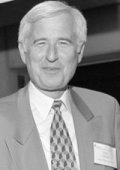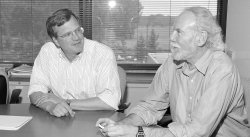 |
|
The Future, First Draft by Kurt Riesselmann
“The charge was an opportunity to plot out the future of the field,” said Barish, physics professor at Caltech. “If we could do it well, we could make a difference.”
Ten months later, in November, Barish and Jonathan Bagger, physics professor at The Johns Hopkins University and also co-chair, released a draft report conceived by a group of 23 physicists from across the country, with research interests ranging from astrophysics to particle colliders to gravitational phenomena.
“It was a very diverse committee,” said John Marriner, Fermilab physicist and member of the subpanel. “Most members were concerned about the diversity of the HEP program, opportunities for students, etcetera.”
According to Marriner, it was impossible for any special-interest group to influence decisions without first gaining broad support. It was up to Barish and Bagger to bring the group together and agree upon a set of recommendations.
Before writing a single sentence of the report, the subpanel spent six months, including a meeting with 1,500 scientists in Snowmass, to gather input from colleagues in high energy physics and related fields. It listened to representatives from NASA as well as physics organizations. And it asked for advice from people familiar with science policy and budgets.
“Representatives of NSF and DOE were at most of our meetings,” said Bagger. “It was very important for them to understand how we reached our conclusions. They were mostly listening.”
Marriner brushed aside any concerns that administrators had too much influence on the content of the draft report.
“DOE people certainly didn’t steer the report in any direction,” he said, pointing out that DOE personnel initially didn’t support one of the four recommendations of the executive summary. “The subpanel also had one private session. But we found that the presence of DOE officials didn’t inhibited our discussions.”
Since November, physicists have had the oppor-tunity to comment on the draft report. Barish and Bagger have begun to travel around the world to present the recommendations for a long-range plan.
“Our plan is in some sense a joint dream for the field,” explained Barish. “The real damper is that the resources are not sufficient. Some programs have been hit very hard, especially here at Fermilab, and it is hard to dream when you are concerned about survival. It is hard to see the opportunities.”
Presentations on the draft report at various laboratories, universities and science organizations have provided valuable feedback.
“Some of the things that we intended to say didn’t come across,” Barish said. “Some things we forgot about. Some good ideas and some improvements have come up.”
Marriner agreed that there are instances in which people truly have misunderstood the report or made interpretations beyond the intentions of the subpanel. But among the criticism that the subpanel has received, he saw a positive aspect.
“One has to keep in mind what people are not criticizing,” he said. “I think there is a lot of support for the report. People worry more about the implementation of the recommendations.”
The subpanel, which is still accepting comments on the draft by email (panel@pha.jhu.edu), will finalize the 92-page report in January and present it on January 28 to the High Energy Physics Advisory Panel, one of six advisory panels of DOE’s Office of Science. If HEPAP approves the submitted report, it will forward it to officials at DOE and NSF
Fred Gilman, chair of HEPAP, is preparing for the work to come.
“We need to carry the message to Congress and the Office of Management and Budget,” said Gilman. “We are preparing a brochure to accompany the report that will be visually appealing, something that can be readily understood.”
Bagger has already started to focus on the implementation of the report’s recommendations.
“Barry and I will not be finished on January 28,” he said. “We need to transmit the report to DOE and NSF officials; talk to scientists from other fields; and present the report to our elected officials. We have just taken the first step.”
For high energy physics, the future has just begun.
Note: Ferminews will provide detailed coverage when the final report is issued in January 2002.
High Energy Physics Advisory Panel |
| last modified 12/14/2001 email Fermilab |
FRLsDFx9eyfrPXgV
 Last January, when asked whether he would serve as co-chair of a committee to review the central scientific issues for the U.S. High Energy Physics program, Barry Barish said no. He was concerned that the committee would be handed a pre-set agenda.
But Barish changed his mind when he read the charge from the Department of Energy and the National Science Foundation. The letter asked the High Energy Physics Advisory Panel to establish a subpanel to develop a long-range plan for the U.S. High Energy Physics program.
Last January, when asked whether he would serve as co-chair of a committee to review the central scientific issues for the U.S. High Energy Physics program, Barry Barish said no. He was concerned that the committee would be handed a pre-set agenda.
But Barish changed his mind when he read the charge from the Department of Energy and the National Science Foundation. The letter asked the High Energy Physics Advisory Panel to establish a subpanel to develop a long-range plan for the U.S. High Energy Physics program.
 “Barry and Jon worked quite well together as a team,” said Marriner. “Their goal was to obtain consensus among the committee members, and they worked hard at it. The executive summary was very carefully written, and I think it is fair to say that it has unanimous support from the subpanel.”
“Barry and Jon worked quite well together as a team,” said Marriner. “Their goal was to obtain consensus among the committee members, and they worked hard at it. The executive summary was very carefully written, and I think it is fair to say that it has unanimous support from the subpanel.”